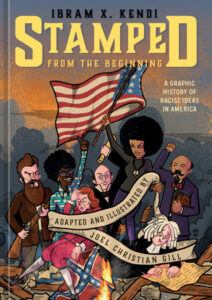I do not have time to read all the books I want to, so when I was offered the graphic history adaptation of Ibram X Kendi’s award-winning Stamped From The Beginning, I absolutely jumped at the chance. Graphic novels and non-fiction are usually a much faster read for me than plain text, and I really loved the cover of this book (plus Joel Christian Gill’s linework is just excellent throughout.)
 Covering the history of anti-Black racism since the founding of America as the nation it is today, via the lens of five important figures on both sides of the fight against racism, this was a super enlightening book for me to read. I only grew up intermittently in the United States, so my education in its history is even sketchier than the average informed student’s. As my own circle of friends and acquaintances has grown — as well as my access to excellent material like this book — I’ve learned a lot more, including the stuff they don’t put in textbooks and, in fact, are fighting to keep out of the curriculum in certain states even in the present day.
Covering the history of anti-Black racism since the founding of America as the nation it is today, via the lens of five important figures on both sides of the fight against racism, this was a super enlightening book for me to read. I only grew up intermittently in the United States, so my education in its history is even sketchier than the average informed student’s. As my own circle of friends and acquaintances has grown — as well as my access to excellent material like this book — I’ve learned a lot more, including the stuff they don’t put in textbooks and, in fact, are fighting to keep out of the curriculum in certain states even in the present day.
Having not read the source material, I can’t say with any certainty how true to the original book this is. Professor Gill acknowledges that Dr Kendi’s Stamped From The Beginning was only one reference point for this volume: an understandable choice given the need to look up what all the historical figures, locales and times depicted here looked like. I do know that this nearly 300-page graphic adaptation of the 500+ page original follows the five-part structure of the original, so a significant condensation must have been applied in order to get all the ideas to fit in here. And for the most part, this works out well, especially when it comes to talking about how to be an antiracist and how to fight racism, even the insidious kind we don’t realize is present in our everyday lives. Frankly, the only criticism I have of this book relates to how certain topics are very conspicuously dropped in ways that can too easily confuse a layperson like me, particularly in the earlier chapters. I know that the climate theory of race is bogus, but it doesn’t even make sense in the way it’s presented in the book. I also wondered why the first Black representative, Hiram Rhodes Revels, was never named but only mentioned in passing by position: a weird omission in a book about seeing Black people as human beings. I also, frankly, wanted to know more about the colonization of Liberia, tho I imagine that’s a whole other book on its own.
Those are very small quibbles tho, especially in the grander scheme of what this book both aims to be and succeeds at doing. I know I’m not the only person with far more time and bandwidth in my life for a graphic novel adaptation than for a weighty non-fiction tome. And I’m highly doubtful that the original material included one of my favorite parts of this book: the little “force ghosts” and related figures commentating on the events in modern slang. Even tho there are bits where I felt that a little too much was cut for space, overall this was a comprehensive and extremely accessible overview of almost four hundred years of United States history.
Most powerful was the commitment to showing the insidiousness of racist ideas, even when espoused by the well-meaning, including Black people themselves. No punches are pulled when it comes to discussing how seemingly conciliatory statements or gestures are in truth deeply racist. The signaling, in particular, where racist statements are almost universally placed in ooze-dripping black speech bubbles, really helps readers learn and confront things they may never even have realized undermine the value of individuals as human beings. It was certainly very educational for me, as someone whose own experiences with racism are wildly varied, with both differences and similarities to what Black Americans have to face today.
I believe that it’s impossible for anyone with at least half a brain and half a heart each to come out of this without siding with Angela Davis, the final focal figure of the book. Antiracism is difficult, meaningful work, and is deeply intersectional at its core. I greatly appreciated how this volume not only describes the long history and evolution of racist ideas in the United States, but also prescribes steps for what to do next, starting with reflecting on one’s own thinking and behavior — arguably the hardest step of all. If you can’t get through the original Stamped, then I highly recommend grabbing this version. It might not be as comprehensive, but it’s still exceptionally powerful, no less so for being accessible to a wider range of reader.
Stamped From The Beginning: A Graphic History Of Racist Ideas In America by Ibram X. Kendi & Joel Christian Gill was published in paperback June 4 2024 by Ten Speed Graphic and is available from all good booksellers, including
